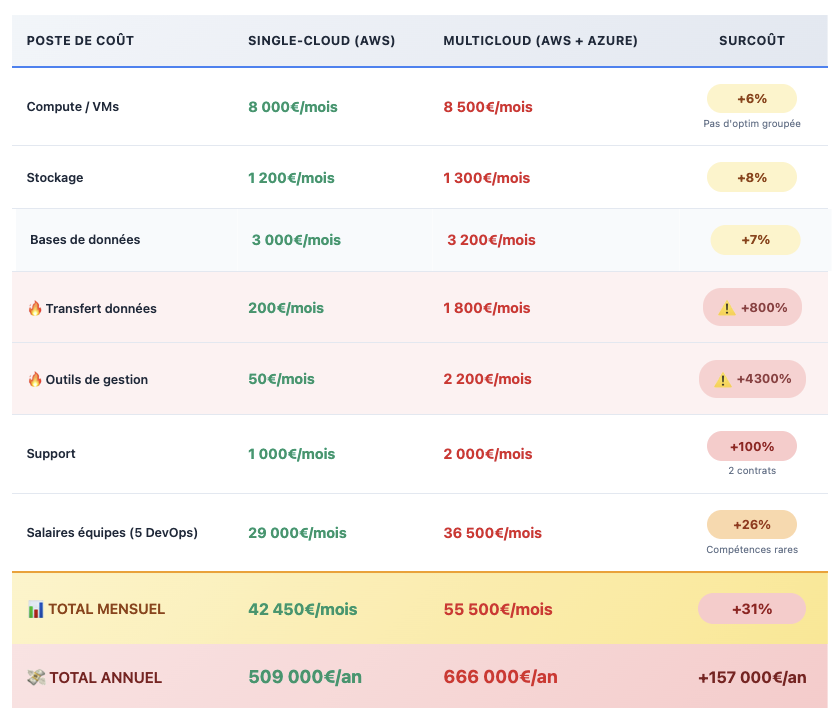Introduction
Multicloud - using AWS, Azure and Google Cloud simultaneously - is sold as the ultimate strategy: avoid vendor lock-in, choose the best service from each provider, negotiate prices by playing the competition. The pitch from consulting firms: "Be agnostic, be free, be resilient". The reality on the ground: 78% of multicloud companies exceed their cloud budget by 30% or more, your ops teams are underwater managing 3 different consoles, and your "portable" application is actually locked into 15 different proprietary services. Between the promised strategic independence and guaranteed operational chaos, there's a gulf of complexity and hidden costs that no one dares put a figure on before committing. This article debunks the myths of multicloud, exposes the real costs (spoiler: 2-3x more expensive than a single cloud), identifies the rare cases where it's worth it, and above all gives you the decision grid that cloud vendors will never show you.
The multicloud myth sold by consulting firms
The seductive marketing pitch
"Use S3 from AWS for object storage (cheapest), Azure for AD and Office 365 (native integration), GCP for BigQuery (better analytics), and Kubernetes everywhere for portability." On PowerPoint, it's magnificent: best-of-breed, maximum flexibility, no dependencies.
Repeated promises:
- Avoid vendor lock-in: if AWS raises its prices by 30%, you can migrate to Azure in 48 hours.
- Ultimate resilience: an AWS region goes down? Your app automatically switches to GCP
- Tariff negotiation: put suppliers in competition to obtain a 40% discount
- Accelerated innovation: get the best from every cloud instantly
The reality nobody tells you before
Vendor lock-in multiplied by 3: you're not free of one vendor, you're a prisoner of three. Each cloud has its own proprietary services (AWS Lambda vs. Azure Functions vs. Cloud Functions), its own SDKs, its own deployment tools. Your "portable architecture" actually uses :
- AWS: RDS, Elastic Load Balancer, CloudFront, IAM
- Azure: Azure AD, Key Vault, Application Gateway
- GCP : BigQuery, Cloud Storage, Pub/Sub
None of these services are compatible between clouds. Kubernetes "portability"? It covers 20% of your technical stack. The remaining 80% (databases, network, security, monitoring) are cloud-specific.
Explosive operational complexity: instead of one console, you manage three. Instead of one IAM system, three incompatible ones. Instead of one VPC network, three network architectures to interconnect (AWS Transit Gateway, Azure Virtual WAN, GCP VPC Peering). Each major service update = triple work of monitoring, testing and deployment.
Astronomical hidden costs:
- Inter-cloud data transfer: 0.08-0.12€/Gb. An app exchanging 10 TB/month between AWS and Azure = 800-1200€/month in bandwidth alone.
- Unified management tools: Terraform Cloud (99/month per organization),Datadogmulticloud(31/month per organization), Datadog multicloud (31/month per organization),Datadogmulticloud(31/host/month vs $15 single-cloud), CloudHealth (2-5% of your cloud bill)
- Rare skills: an AWS DevOps costs 65k€/year. A DevOps mastering AWS + Azure + GCP = 85-95k€/year (when you find him)
Fragmented support: a critical incident that crosses 2 clouds = coordination nightmare. AWS support blames Azure, Azure blames GCP, nobody is responsible. Average resolution time: 3x longer than single-cloud.
The 3 real (and legitimate) reasons to go multicloud
1. Regulatory constraints and data sovereignty
Context: you operate in 15 countries with strict data localization laws. China requires Alibaba Cloud or Huawei Cloud for local hosting. Russia requires servers on Russian soil (Yandex Cloud). The EU is pushing for sovereign clouds (OVHcloud, Scaleway, T-Systems).
Why multi-cloud is mandatory: no single global provider covers all regulatory requirements. You have no choice: AWS for Europe/US, Alibaba Cloud for China, local cloud for Russia.
Realistic cost: distributed architecture + data synchronization + multi-jurisdictional compliance = 40-60% more expensive than a single global cloud. But the RGPD fine or operating ban costs infinitely more.
2. Acquisition or merger of companies
Context: your company has been running on Azure for 10 years (500 VMs, 200 apps). You're buying out a competitor who runs 100% on AWS (Terraform infrastructure, AWS-native team, critical dependencies).
Why multicloud becomes inevitable: migrating all acquired infrastructure to Azure = 18-24 months project, 2-5M€ costs, major operational risk during switchover. Keep AWS temporarily (2-3 years) = pragmatic.
Frequent mistake: letting the situation fester. 5 years after the acquisition, you still have 2 clouds with no consolidation strategy. Duplication costs pile up: duplicate tool licenses, separate teams, data silos.
Best practice: temporary multicloud with a clear convergence roadmap. "In 3 years, 80% on Azure, AWS limited to non-migratable critical legacy apps". Otherwise, you're drifting towards an endured multicloud.
3. Best-of-breed for hyper-specialized functions
Context: you're a fintech doing intensive machine learning. GCP has Vertex AI and TPU v5 (best perf/price ratio for model training). Your main infrastructure is on AWS. Your AD and Office 365 are on Azure (10,000 users, impossible to migrate).
Why it can be justified: the performance/cost differential on ML is significant (30-40% cheaper on GCP for certain workloads). If your core business is ML and you consume 200k€/year of GPU compute, saving 60-80k€/year justifies the complexity.
Conditions of viability:
- Isolated workload (no massive data exchanges with the rest of the infrastructure)
- Dedicated team with GCP expertise
- ROI >100k€/year minimum to compensate for complexity
- No more than 2 clouds (AWS + GCP), never 3+.
Critical threshold: below €500k/year of total cloud expenditure, best-of-breed multicloud is ALWAYS ROI negative. Management costs eat up the savings.
5 cases where multicloud is a catastrophic mistake
1. The start-up/SME that wants to "keep it all open
Symptom: "We're going to use Kubernetes to stay cloud-agnostic, so we can switch clouds easily if prices go up."
Why it's stupid: you've got 10 developers, €50k/month cloud bill, zero leverage to negotiate. Remain "agnostic" = 40% extra cost (tools, complexity, time lost) to avoid a theoretical risk of price increases.
Brutal calculation: €50k/month single-cloud vs €70k/month multi-cloud = €240k/year extra cost to protect against a hypothetical 20% increase (which would represent €120k). You're paying 2x the amount of the risk you're trying to avoid.
Real solution: annual commitments (15-20% reduction), cost monitoring, no multicloud before €500k/year expenditure.
2. The fantasy of inter-cloud high availability
Symptom: "We're going to put our app on AWS us-east-1 and Azure West Europe. If AWS goes down, we'll switch to Azure automatically."
Why it's an illusion:
- Real-time data synchronization between clouds = 100-300ms latency (unacceptable for 90% of apps)
- Cost of duplication: you pay for TWO complete infras permanently for an event that occurs 0.01% of the time.
- Complexity of failover: testing an AWS → Azure failover = 50 man-days. Getting it up and running in production = 6 months of fine-tuning.
- Inter-cloud bandwidth: 10Tb/month replicated = €1,000/month in transfer costs alone
True high availability: multi-region IN THE SAME CLOUD. AWS us-east-1 + us-west-2 = 99.99% availability, 60ms latency, 0.01€/Gb inter-region transfer cost (10x cheaper), native tools (Route 53, CloudFront). Real availability identical to multicloud, 5x less complexity.
Real figures: AWS us-east-1 has had 4 major outages in 10 years (2-8h downtime). Is your app really so critical that you need to spend 2x the infra H24 to avoid 20h of downtime in 10 years? For 99.99% of companies: no.
3. Multicloud "just in case" without strategy
Symptom: "We're on AWS but we're also going to provision Azure because some customers may ask for it one day."
Consequence: you maintain 2 environments, but Azure represents only 5% of your traffic. Management costs = 40% of your ops time to serve 5% of your workloads. Teams become less expert everywhere (diluted knowledge).
Error of reasoning: treat all clouds equally. If Azure = 5% of the business, treat it that way: minimal infrastructure, no feature parity with AWS, reduced team. Or assume and stay 100% AWS.
Case study: 200-strong SaaS company, 90% on AWS, 10% on Azure "to have the option". Result: Azure incidents 3x more frequent (less competent team), Azure costs 2x higher (no optimization), abandonment after 2 years with €600k in cumulative additional costs.
4. Multicloud to "put suppliers in competition".
Symptom: "We're going to deploy on AWS and GCP, so we can negotiate both and take the cheapest."
Cloud negotiation reality:
- 10-15% discount available on FIRM commitments of €500k/year or more over 1-3 years
- 25-30% discount from €2M/year commitment
- Suppliers will only negotiate if you COMMIT to volume. Staying "open" = zero bargaining power
Commercial truth: AWS offers you a 20% discount if you sign up for 1M€/year over 3 years. You stay multicloud 50/50 AWS/GCP = 500k€/year per cloud = 5% discount max. You lose 15% discount (150k€) to keep the "option" to change.
The catch: cloud providers are NOT stupid. They know that migration = 12-18 months. You won't migrate mid-contract. Your leverage = non-existent once deployed.
5. Kubernetes = magical portability (the biggest lie of all)
Symptom: "We dock everything, we put Kubernetes on, we're portable between AWS EKS, Azure AKS and GCP GKE."
What 's portable (20% of your stack):
- Application containers (business code)
- Kubernetes deployment YAML files (with minor adaptations)
What is NOT portable (80% of your stack):
- Managed databases (RDS ≠ Azure SQL ≠ Cloud SQL)
- Load balancers (AWS ALB ≠ Azure Application Gateway ≠ GCP Load Balancing)
- SSL/TLS certificates (AWS Certificate Manager ≠ Azure Key Vault ≠ GCP Certificate Manager)
- Monitoring (CloudWatch ≠ Azure Monitor ≠ Cloud Logging)
- IAM and security (AWS IAM ≠ Azure RBAC ≠ GCP IAM)
- Network (VPC, subnets, security groups = all different)
- Persistent storage (EBS ≠ Azure Disk ≠ GCP Persistent Disk)
- Backup and disaster recovery (completely cloud-specific)
Actual migration time of a Kubernetes app between clouds: 3-6 months for an average app (50 microservices), not 2 days. Every cloud-native service needs to be rewritten or replaced. CI/CD pipelines to be redone. Network configurations to be reviewed. Access and permissions to be recreated.
Migration cost: 150-300 man-days = €100-200k. How often do you have to do it? Never, barring a catastrophe. So you're paying for permanent "portability" (extra abstraction costs) for something you'll never use.
The real costs of multicloud (and why no one has quantified them before)
Structure of hidden costs
1. Inter-cloud data transfer: the silent killer
Actual rates (October 2025) :
- AWS → Internet: €0.09/GB (first 10 TB/month)
- Azure → Internet: €0.08/GB
- GCP → Internet: €0.12/Gb
- Between clouds (AWS ↔ Azure ↔ GCP): 0.08-0.12€/GB in BOTH directions
Application example:
- AWS app that queries an Azure database: 5 TB/month exchanged = €400-600/month
- S3 ↔ Blob Storage synchronization: 20Tb/month = €1600-2400/month
- Data pipeline AWS → BigQuery: 50 TB/month = €4000-6000/month
Over 3 years, for an average app (15Tb/month inter-cloud): 43k€-65k€ JUST IN BANDWIDTH. This cost does not exist in single-cloud (inter-region transfer = 0.01-0.02€/Go, i.e. 10x cheaper).
2. Multiplexed management tools and observability
Single-cloud (AWS):
- CloudWatch: included, €10/month additional logs
- AWS Config: €0.003 per configuration record
- Total: ~€50/month for 50 resources
Multicloud :
- Datadog (multicloud monitoring): €31/host/month x 50 = €1,550/month
- Terraform Cloud (Teams): €70/month
- CloudHealth (FinOps): 2-3% of cloud invoice, i.e. €500/month for €20k/month expenditure
- Total: ~€2200/month
Annual extra cost: 26k€ vs 600€ = 25,4k€/year just to have visibility.
3. Skills and training teams
Training costs (certifications + courses) :
- AWS Solutions Architect Associate: €3,000/person (training + exam + time)
- Azure Solutions Architect Expert: €3,500/person
- GCP Professional Cloud Architect: €3,000/person
Multicloud DevOps team of 5: €9500/person = €47.5k initial training. To be partially renewed each year (15k€/year) to maintain skills.
Premium salary: DevOps multicloud = +25-30% vs single-cloud. Out of 5 people at €70k/year = €87.5k → savings of €17.5k/year x 5 = €87.5k/year by remaining single-cloud.
4. Duplicate software licenses
Third-party software examples :
- MongoDB Atlas database: AWS + Azure deployment = 2 clusters = cost x2
- Redis Enterprise: license per cloud cluster
- Elasticsearch: license per deployment
Grouping savings: 100 MongoDB nodes on AWS = 30% volume reduction. 50 AWS nodes + 50 Azure nodes = no volume reduction.
Real comparative calculation: single vs. multicloud
Scenario: 100-person company, standard web + data workload

Over 3 years: €471k in additional multicloud costs. This amount covers :
- 4 full-time developers for 3 years
- Or 30% more features
- Or €470,000 margin
ROI required to justify multicloud: you need to prove that multicloud brings you >160k€/year in benefits (resilience, negotiation, innovation). In 95% of cases: impossible to prove.
The decision checklist: should you really go multicloud?
Questions to ask yourself BEFORE making a commitment
Question 1: What is the size of your annual cloud expenditure?
- < 200k€/an → Single-cloud obligatoire. Aucune justification économique pour le multicloud.
- 200-500k€/year → Single-cloud by default, multicloud only if absolute regulatory constraint.
- 500k-2M€/year → Multicloud possible if justified best-of-breed use case with quantified ROI >100k€/year.
2M€/year → Multicloud viable with dedicated team, but always challenge ROI.
Question 2: Do you have strict regulatory constraints on data localization?
- No → No reason to go multicloud
- Yes, but only one cloud covers them (e.g. AWS covers EU + US) → Single-cloud is enough
- Yes, and no single cloud covers everything (e.g. China + Russia + EU) → Multicloud mandatory
Question 3: How many people are on your infra/DevOps team?
- < 3 → Single-cloud obligatoire. Pas assez de bande passante pour gérer la complexité.
- 3-5 → Single-cloud recommended. Multicloud possible but risky (team burnout).
- 5-10 → Multicloud possible, with specialized teams for each cloud.
10 → Multicloud viable with Center of Excellence per cloud.
Question 4: What percentage of your stack uses cloud-native managed services?
50% (RDS, Lambda, S3, DynamoDB, etc.) → Inter-cloud migration = nightmare. Stay single-cloud.
- 30-50% → Migration possible but costly (100-200k€). Difficult to justify.
- < 30% (majoritairement Kubernetes + OSS) → Portabilité envisageable, mais vérifier les 80% non-portables.
Question 5: Do you have a quantified, measurable ROI for multicloud?
- No / "It's strategic" / "To avoid the lock-in" → STOP. Don't go there.
- Oui, économie ML 60k€/an sur GCP → Potentiellement viable, si surcoûts <60k€/an.
- Yes, business-critical resilience → Cipher cost of downtime vs. cost of multicloud. 99% of the time, multi-region single-cloud is enough.
Final decision grid
You MUST go multicloud if:
- Multi-country regulatory constraints impossible to cover with a single supplier
- Acquisition/merger with 2 existing clouds (temporary, with convergence roadmap)
- Ultra-specialized workload with proven ROI >100k€/year (e.g. ML on GCP TPU)
- Cloud expenditure >€2M/year + team >10 people + executive sponsor
You should AVOID multicloud if:
- Dépense cloud <500k€/an (surcoûts mangent tout bénéfice)
- Équipe <5 personnes (impossible à gérer)
- Justification = "to avoid lock-in" without precise costing
50% cloud-native managed services (no migration possible)
- No measurable ROI >100k€/year
Grey zone (500k€-2M€/year, team of 5-10 people) :
- Calculate precise additional costs (template provided above)
- Identify measurable, quantified benefits (no wishful thinking)
- Launch a 6-month POC with 1 secondary workload before generalizing
- Measure actual ops time consumed (hours/week)
- Decide on DATA, not on conviction
The intelligent alternative: the "main cloud + documented exceptions" strategy
The 80/20 model that works
Principle: one main cloud (AWS, Azure or GCP depending on your context) covers 80-90% of requirements. Justified and documented exceptions use a second cloud.
Example of pragmatic architecture:
Main cloud : AWS (85% of workloads)
- Web applications (EC2, Lambda, API Gateway)
- Databases (RDS, DynamoDB)
- Storage (S3, EFS)
- Backbone network (VPC, Transit Gateway)
Azure exceptions (15% of workloads):
- Azure AD (10,000 users, impossible to migrate)
- Microsoft 365 (Exchange, SharePoint, Teams)
- Legacy .NET applications requiring Windows Server + SQL Server (licensing included in Azure)
Benefits:
- Expert AWS team (70% of their time on AWS)
- 90% shared tool costs on AWS
- Inter-cloud transfers limited to the bare essentials (SSO authentication)
- Controlled complexity
Strict governance:
- All new apps = AWS by default
- Azure exception = written justification + archi validation + quarterly review
- No 3rd cloud (GCP) without an exceptional business case
Architectural patterns that limit pain
Pattern 1: Main cloud with specialized satellites
Central infrastructure on AWS, specific workloads on other clouds :
- ML/AI intensive → GCP (Vertex AI, TPU)
- Chinese environment → Alibaba Cloud (legal constraint)
- Scientific HPC → Azure (SLURM integration)
Maximum isolation between satellites and core. Standardized REST APIs for communication.
Pattern 2: Geographic multi-cloud
Each geographical region has its own optimal cloud:
- Europe: AWS (data sovereignty RGPD, strong presence)
- Asia-Pacific: Alibaba Cloud + AWS (country-dependent)
- North America: AWS or Azure (depending on legacy)
No inter-cloud communication between regions (natural geographic isolation).
Pattern 3: Secondary cloud for "cold" disaster recovery
Main cloud active, secondary cloud on standby for DR only :
- 100% AWS production
- Replicated backups on Azure (cool/archive storage)
- Runbooks tested 2x/year
- Azure infrastructure provisioned on demand in the event of disaster
Cost: 10-15% of an active/active multicloud. Resilience: 80% as good.
Conclusion: multicloud is not a religion, it's a business choice
Multicloud is neither a strategic no-brainer nor a technical heresy. It's a cost/complexity/benefit trade-off that needs to be calculated coldly.
Inconvenient truths:
- For 80% of companies, multicloud = 30-50% additional cost with no measurable benefit
- Vendor lock-in is a false problem: you'll never migrate (prohibitive cost, high risk).
- Kubernetes doesn't make you portable (only 20% of your stack)
- Cloud providers won't lower their prices in the face of "competition" if you're already deployed
- Multi-cloud resilience costs 2x multi-region single-cloud resilience for identical availability
Legitimate cases (rare):
- Regulation impossible with a single cloud
- Acquisition/merger (temporary)
- Specialized workload with proven ROI >100k€/year
- Very large companies (>2M€/year cloud) with dedicated teams
The winning strategy 2025:
- Default: single-cloud with the provider best aligned with your existing technology stack
- Documented exceptions for cases where a second cloud brings measurable benefits >100k€/year
- Strict governance: no anarchic multicloud, every exception must be justified and reviewed
- Invest in cloud expertise rather than mediocrity on three clouds
The fatal mistake: going multicloud out of fear of lock-in or out of principle, with no quantified ROI. You're burning €150-300k/year to protect yourself against a theoretical risk that will never materialize.
The blunt advice: if you can't put a precise figure on the benefits of multicloud in euros and cents, stick with single-cloud. Your CIO and ops team will thank you, and so will your finances.
Recommended next steps
- Audit your current usage: list all services used by cloud, identify proprietary dependencies
- Calculate your real costs: use the template provided to estimate the multi-cloud vs. single-cloud cost premium.
- Challenge every workload: for every app on a secondary cloud, ask "what measurable benefit justifies the complexity?"
- Define your cloud strategy: main cloud + documented exceptions, no default multicloud
- Train your teams: deep expertise in one cloud > superficial knowledge of three
Multicloud is a luxury that only large organizations can afford. For others, it's a financial and operational trap disguised as a strategy for the future.
Don't be multi-cloud on principle. Be multi-cloud by proven necessity, or remain single-cloud by pragmatism.
.svg)






.svg)